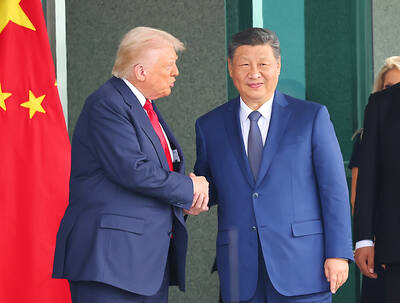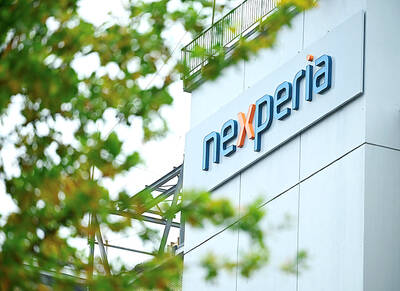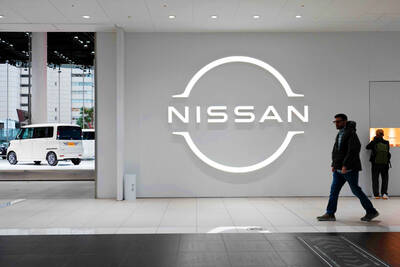AU Optronics Corp (AUO, 友達光電) yesterday posted smaller quarterly losses as higher TV panel prices helped cushion the effect of a slow season and supply chain disruptions due to the COVID-19 pandemic.
While it was the fifth consecutive quarter that the company ended up in the red, net losses of NT$4.99 billion (US$167.44 million) last quarter were significantly smaller than losses of NT$8.83 billion in the previous quarter and NT$3.69 billion a year earlier.
The pandemic significantly impacted whole supply chains, as anti-virus measures and transportation restrictions caused a labor shortage and component supply crunch in the first quarter, AUO said, adding that inventories jumped 18.8 percent sequentially to NT$27.88 billion last quarter.
Average selling prices dropped 0.67 percent to US$296 per square meter last quarter from US$298 a quarter earlier, it said.
However, the company expects the pandemic to be a boon this quarter, as remote learning, work-from-home and play-at-home trends are spurring demand for flat panels used in laptops, PC monitors and medical devices.
As a result, large-sized panel shipments are forecast to grow 20 percent sequentially this quarter, while average selling prices are expected to drop about 5 percent, it said.
“We saw some positive impact from the pandemic. Because of stay-at-home, work-from-home and e-schooling trends, we saw significant increases in demand for our information technology [IT] products,” AUO chairman Paul Peng (彭双浪) told investors.
To cope with rising demand for advanced IT panels, AUO is to roll out new 4K mini-LED panels used in 27-inch and 32-inch laptops next quarter, targeting content creators and PC game players.
Overall, “second-quarter revenue will be better than the first quarter,” Peng said.
AUO posted revenue of NT$53.69 billion last quarter, down 13.42 percent quarterly and 19.51 percent annually.
Due to the shutdown of TV assembly lines in Mexico and other parts of the world due to coronavirus containment measures, AUO said it holds a “conservative” view about TV panel shipments this quarter.
Supply chain disruptions and the postponement of the Tokyo Olympic Games are affecting demand for TV panels, it said.
Shipments of small-sized panels are expected to drop a low-single-digit percentage this quarter amid dwindling demand for displays used in smartphones and automobiles, AUO said.
Business visibility for the second half of this year is unclear as the pandemic is taking a toll on the global economy and job market, and dampening consumer confidence, Peng said.
On the plus side, the travel bans would limit panel supply from new fabs and should help improve the industry’s supply-and-demand dynamics, he said.

TEMPORARY TRUCE: China has made concessions to ease rare earth trade controls, among others, while Washington holds fire on a 100% tariff on all Chinese goods China is effectively suspending implementation of additional export controls on rare earth metals and terminating investigations targeting US companies in the semiconductor supply chain, the White House announced. The White House on Saturday issued a fact sheet outlining some details of the trade pact agreed to earlier in the week by US President Donald Trump and Chinese President Xi Jinping (習近平) that aimed to ease tensions between the world’s two largest economies. Under the deal, China is to issue general licenses valid for exports of rare earths, gallium, germanium, antimony and graphite “for the benefit of US end users and their suppliers

Dutch chipmaker Nexperia BV’s China unit yesterday said that it had established sufficient inventories of finished goods and works-in-progress, and that its supply chain remained secure and stable after its parent halted wafer supplies. The Dutch company suspended supplies of wafers to its Chinese assembly plant a week ago, calling it “a direct consequence of the local management’s recent failure to comply with the agreed contractual payment terms,” Reuters reported on Friday last week. Its China unit called Nexperia’s suspension “unilateral” and “extremely irresponsible,” adding that the Dutch parent’s claim about contractual payment was “misleading and highly deceptive,” according to a statement

Nissan Motor Co has agreed to sell its global headquarters in Yokohama for ¥97 billion (US$630 million) to a group sponsored by Taiwanese autoparts maker Minth Group (敏實集團), as the struggling automaker seeks to shore up its financial position. The acquisition is led by a special purchase company managed by KJR Management Ltd, a Japanese real-estate unit of private equity giant KKR & Co, people familiar with the matter said. KJR said it would act as asset manager together with Mizuho Real Estate Management Co. Nissan is undergoing a broad cost-cutting campaign by eliminating jobs and shuttering plants as it grapples

The Chinese government has issued guidance requiring new data center projects that have received any state funds to only use domestically made artificial intelligence (AI) chips, two sources familiar with the matter told Reuters. In recent weeks, Chinese regulatory authorities have ordered such data centers that are less than 30 percent complete to remove all installed foreign chips, or cancel plans to purchase them, while projects in a more advanced stage would be decided on a case-by-case basis, the sources said. The move could represent one of China’s most aggressive steps yet to eliminate foreign technology from its critical infrastructure amid a